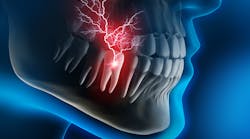Can a preprocedural topical benzocaine polish reduce dentinal hypersensitivity?
An estimated one in three adults struggle with dentinal hypersensitivity.1 The most common cause of dentinal hypersensitivity is the exposure of dentinal tubules as a result of gingival recession.2 When prophy paste containing NovaMin became an option to treat dentinal hypersensitivity, I offered sensitive patients a prepolish with this formula prior to scaling.
NovaMin is a compound made from elements critical for bone and tooth mineralization: calcium, sodium, phosphorus, and silica. When in contact with saliva or water, NovaMin produces a crystalline hydroxyl-carbonate apatite layer that’s chemically and structurally the same as tooth mineral. In addition to supercharged remineralization actions, desensitizing qualities, and inhibiting the development of caries, studies have shown antimicrobial/anti-inflammatory benefits of using Novamin.3
While this offered a large population some relief from dentinal hypersensitivity during scaling appointments, there was still a large portion of patients who continued to request topical benzocaine preprocedurally. Topical benzocaine is sticky, hard to apply, and increases salivary flow, making it a challenge to use use in combination with scaling.
Conducting an experiment
Since the NovaMin polish is applied as a polish with a rubber cup, I wondered if topical benzocaine could be applied using the same technique. I experimented on prophylaxis patients with dentinal hypersensitivity. I filled a rubber cup with topical benzocaine and polished along the gingival margin of all teeth in one quadrant prior to scaling.
There was a high acceptance rate with this technique, and most of my patients experienced a superior tolerance to the scaling procedure. It was also easier than applying topical benzocaine to the gingival margin using a cotton swab.
Topical benzocaine is an ester local anesthetic that works by reversibly binding to and inhibiting sodium channels in the neuronal cell membrane. This blockage prevents the transmission of nerve impulses along nerve fibers and at nerve endings.4 This application temporarily relieves pain or dentinal hypersensitivity without causing many side effects to the patient or clinician.
It has a rapid onset and lasts approximately 10 minutes, providing sufficient time to instrument the teeth in the quadrant where it’s been applied.5 Topical benzocaine has a reputation of few to no side effects and low potential for systemic toxicity for healthy individuals.
However, it’s important to review a patient’s medical history prior to the application of topical benzocaine. Children under age two, elderly patients with methemoglobinemia, and a history of hyaluronidase or St. John’s Wort use are contraindicated for use of topical benzocaine.6
It’s my hope that by sharing what I’ve learned, other hygienists and patients will benefit from this tip.
References
1. Patient impact of dentin hypersensitivity. Haleon HealthPartner. Accessed June 20, 2024. https://www.haleonhealthpartner.com/en-us/oral-health/conditions/sensitivity/psychology-of-sensitivity/dentin-hypersensitivity/
2. Jacobson PL, Bruce G. Clinical dentin hypersensitivity: understanding the auses and prescribing a treatment. Journal of Contemporary Dental Practices. Accessed June 20, 2024. https://www.thejcdp.com/doi/pdf/10.5005/jcdp-2-1-27
3. DiGangi P. Powered by Novamin. RDH, February 1, 2009. Accessed June 20, 2024. https://www.rdhmag.com/patient-care/rinses-pastes/article/16405035/powered-by-novamin
4. Benzocaine: uses, interactions, mechanism of action. Accessed June 20, 2024. DrugBank. https://go.drugbank.com/drugs/DB01086
5. Logothetis DD. Local Anesthesia for the Dental Hygienist. Third Ed. 2021. Elsevier. Health Sciences Division.
6. Benzocaine (oral route, oromucosal route). Mayo Clinic. February 1, 2024. Accessed 21 June 2024. https://www.mayoclinic.org/drugs-supplements/benzocaine-oral-route-oromucosal-route/side-effects/drg-20072824?p=1
About the Author

Kara Koller, PHDHP, RDH, AAS
Kara Koller, PHDHP, RDH, AAS, has 24 years of clinical experience as a preventive care provider. She graduated from Pennsylvania College of Technology, earning her associate’s in applied science in dental hygiene with special recognition in public health. Kara applied for her public health dental hygiene practitioner license and volunteers her educational services to the elderly. She’s licensed to administer local anesthetics, and currently works part-time in a general dentistry practice and part-time in a periodontal and implant practice in York, Pennsylvania.


